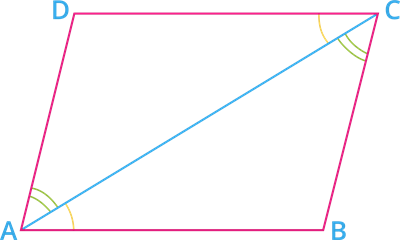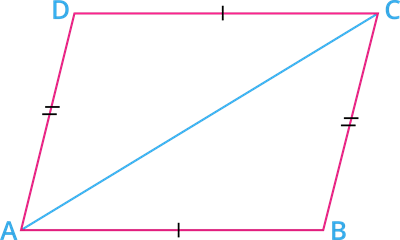UPSKILL MATH PLUS
Learn Mathematics through our AI based learning portal with the support of our Academic Experts!
Learn moreTheorem I:
A diagonal of a parallelogram divides it into two congruent triangles.

Given: ABCD is a parallelogram, and AC is a diagonal.
Diagonal divides the quadrilateral into two triangles ABC and ADC.
To prove: \Delta ABC \cong \Delta CDA
Proof: We know that "the opposite sides of a parallelogram are parallel".
AB \ || \ DC and BC \ || \ AD
Since AB \ || \ DC and AC is a transversal,
\angle BAC = \angle DCA [alternate interior angles] - - - - - (I)
Also, BC \ || \ AD and AC is a transversal,
\angle BCA = \angle DAC [alternate interior angles] - - - - - (II)
In \Delta ABC and \Delta CDA:
\angle BAC = \angle DCA [from (I)]
\angle BCA = \angle DAC [from (II)]
AC = AC [Common side]
Thus, \Delta ABC \cong \Delta CDA [by ASA congruence rule].
Therefore, the diagonal of a parallelogram divides it into two congruent triangles.
Theorem II:
In a parallelogram, opposite sides are equal.

Given: ABCD is a parallelogram, and AC is a diagonal.
Diagonal divides the quadrilateral into two triangles ABC and ADC.
To prove: AB = CD and BC = AD
Proof: We know that "the opposite sides of a parallelogram are parallel".
AB \ || \ DC and BC \ || \ AD
Since AB \ || \ DC and AC is a transversal,
\angle BAC = \angle DCA [alternate interior angles] - - - - - (I)
Also, BC \ || \ AD and AC is a transversal,
\angle BCA = \angle DAC [alternate interior angles] - - - - - (II)
In \Delta ABC and \Delta CDA:
\angle BAC = \angle DCA [from (I)]
\angle BCA = \angle DAC [from (II)]
AC = AC [Common side]
Thus, \Delta ABC \cong \Delta CDA [by ASA congruence rule].
Corresponding parts of congruent triangles are equal.
\Rightarrow AB = DC and BC = AD.
Therefore, the opposite sides of a parallelogram are equal.
Theorem III:
If each pair of opposite sides of a quadrilateral is equal, then it is a parallelogram.

Given: ABCD is a quadrilateral, where AB = DC and BC = AD.
Construction: Join the diagonal AC.
To prove: ABCD is a parallelogram.
Proof: In \Delta ABC and \Delta CDA:
AB = DC [Given]
BC = AD [Given]
AC = AC [Common side]
Thus, \Delta ABC \cong \Delta CDA [by SSS congruence rule].
\implies \angle BAC = \angle DCA [by CPCT] - - - - (I)
\implies \angle BCA = \angle DAC [by CPCT] - - - - (II)
These angles are alternate interior angles.
We know that "the alternate interior angles are equal only when the lines are parallel".
So, AB \ || \ DC and BC \ || \ AD.
Hence, ABCD is a parallelogram.
Important!
CPCT - Corresponding Parts of Congruence Triangles